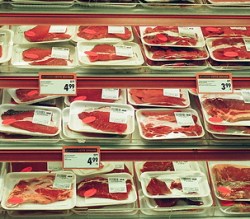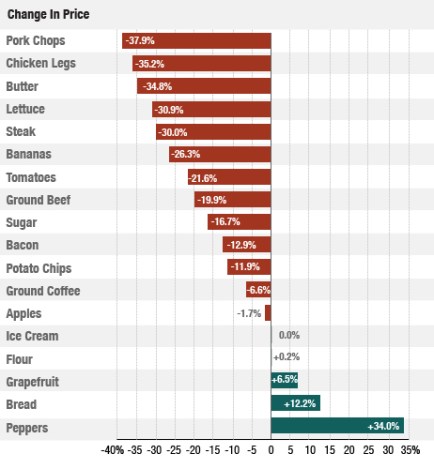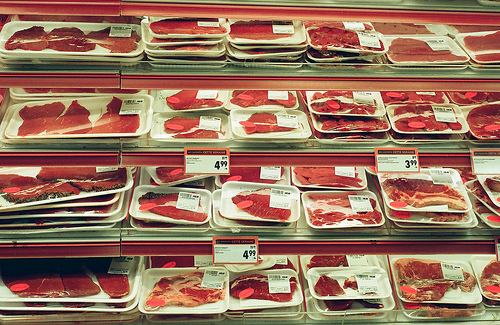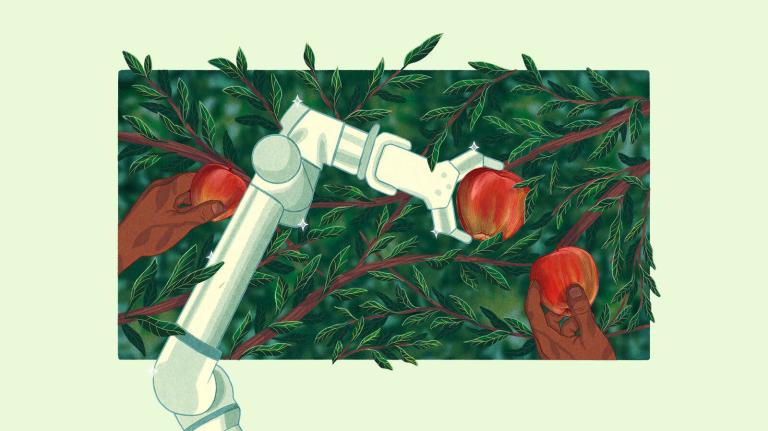
Photo by Nick Castonguay.
I’ve noticed that quite a few Grist readers have been struck by our coverage of shockingly high food prices in Inuit communities in Canada’s far north. It’s less a story of life in extreme lands than the culmination of a historical destruction of indigenous peoples’ traditional foodways combined with a conservative government’s unwillingness to help them adapt.
How appropriate then that NPR’s Planet Money, as part of its Graphing America series, should look at how America’s food spending has changed over the last 30 years. The headline figure — the one Secretary of Agriculture Tom Vilsack is proudest of — is that we spend just under 9 percent of our income on food, about 30 percent less than we did in 1982.

Image courtesy of NPR.
Despite the drop, our shopping baskets have stayed more or less the same — with one notable exception. Processed foods now take the lion’s share of our collective food spending — their share has doubled in the last 30 years. On a percentage basis, we’re spending about the same as we did back then on fruits and vegetables, dairy, bread, and even beverages. Spending on meat, however, has dropped by a third — some of that savings goes to other kinds of spending, of course, since overall food spending is down, but clearly some of the money formerly spent on meat has shifted to processed snacks, treats, and packaged foods.
In fact, while fruit and vegetable prices overall have increased faster than inflation (though Planet Money points out that certain items like apples, lettuce, and even tomatoes have defied that trend, at great cost to farm laborers) — it’s those meat prices that demonstrate the most shocking price drop.
Thank you, Smithfield, Tyson, and Cargill! Many will argue that this is a very positive development. Meat used to be a luxury good and is now readily available to many more people at more income levels. The problem, of course, is that the drop in retail price also represents a massive cost shift. As the meat industry consolidated, industrialized, and specialized, labor costs dropped — but rural unemployment soared.
Meanwhile, the environmental costs of livestock farming, which were manageable when fewer animals in smaller farms were distributed over larger areas, were shifted, too. And in ways that are both difficult to ignore and to address — we’ve polluted rivers with runoff from pork, dairy, and chicken operations, and created massive dead zones in bays and gulfs around the country.
There’s a human cost, too. Workers in the giant slaughterhouses that now dominate the meat industry labor in some of the worst workplace conditions in the country and are prone to illness and injury. Workers in the facilities where the animals are raised have also been pushed to the limit — mistreatment of animals appears to be all too common. Oh, and let’s not forget the human cost to consumers, as the tragedy that results from antibiotic-resistant infections and mass distribution of meat contaminated with deadly pathogens represents far more than unwelcome statistics.
And then there are the animals themselves. Animal welfare went out the window with industrialization; when animals are seen as widgets in a factory, they get treated as such. From the way the animals are bred — such as chickens with oversized breasts that are unable to walk — to the need to pump them full of antibiotics simply so they can survive the disease-ridden, stressful facilities in which they live, most farm animals’ lives are nasty, brutish, and short. (The philosophers among you might note the irony that these animals exist in the Hobbesian “state of nature” while at the same time in a completely artificial environment.)
I’d also feel better about this reduction in food spending if it didn’t coincide with the shift toward processed food and the onset of the obesity epidemic. We’re spending less for food, but we’re also clearly eating far worse. Researchers estimate that obesity now adds thousands of dollars to all Americans’ insurance premiums whether they’re obese or not. Kinda ruins the benefit of cheap food, doesn’t it? And as The New York Times reports, it’s an epidemic that hits low-income communities hardest and remains especially difficult to address.
And then there’s the fact that despite low prices, there are still so many damn hungry people in this country. Almost 50 million Americans are considered “food insecure” by the USDA, and food stamp use is higher than ever. In fact, the relentless focus on lowering food spending obscures the much larger problem — that middle class wages have stagnated over the same period. At the same time, health-care spending has increased radically — although that comes mostly in the form of companies paying more for workers’ insurance premiums rather than giving them raises.
So the next time you hear a government official or a corporate executive touting the benefits of an industrialized food system that allows Americans to spend less than ever on food, just remember: You get what you pay for.



